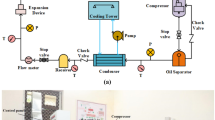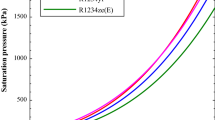Abstract
Most modern refrigerators incorporate heat transfer between the refrigerant in a capillary tube and the refrigerant in a suction line. This heat transfer is achieved by a non-adiabatic capillary tube called a capillary tube-suction line heat exchanger and is supposed to improve the performance of the small vapor compression refrigeration cycle by removing some enthalpy of the refrigerant at the evaporator entrance. To investigate the effects of this heat transfer on the refrigeration cycle, a computer program was developed based on conservation equations of mass, momentum, and energy. The non-adiabatic capillary tube model is based on a homogeneous two-phase flow model. The simulation results show that both the location and length of the heat exchange section influence the coefficient of performance (COP) as well as the cooling capacity. It is noteworthy that the influence was not monotonic; that is, the performance may be deteriorated under certain conditions.
Similar content being viewed by others
References
L. O. S. Buzelina, S. C. Amicoa, J. V. C. Vargasa and J. A. R. Parise, Experimental development of an intelligent refrigeration system, International Journal of Refrigeration, 28 (2005) 165–175.
P. A. Domanski, Theoretical evaluation of the vapor compression cycle with a liquid-line/suction-line heat exchanger, economizer, and ejector, NIST Report: NISTIR5606 (1995).
J. H. Heo, M. W. Jeong, J. U. Jeon and Y. C. Kim, Effects of gas injection on the heating performance of a two-stage heat pump using a twin rotary compressor with refrigerant charge amount, International Journal of Air-Conditioning and Refrigeration, 16 (2008) 77–82.
E. Dirik, C. Inan and M. Y. Tanes, Numerical and experimental studies on adiabatic and non-adiabatic capillary tubes with R-134a, International Refrigeration Conference at Purdue, West Lafayette, Indiana, USA (1994).
M. M. Mezavila and C. Melo, CAPHEAT: a homogeneous model to simulate refrigerant flow through non-adiabatic capillary tubes, International Refrigeration Conference at Purdue, West Lafayette, Indiana, USA (1996).
P. K. Bansal and A. S. Rupasinghe, An empirical model for sizing capillary tubes, Int J Refrigeration, 19 (1996) 497–505.
J. M. Choi, Y. H. Jang and Y. C. Kim, A generalized correlation and rating charts for mass flow rate through capillary tubes with several alternative refrigerants, International Journal of Air-Conditioning and Refrigeration, 12 (2004) 192–197.
G. Valladares, C. D. Perez-Sagarra and A. Oliva, Numerical simulation of capillary expansion devices behaviour with pure and mixed refrigerants considering metastable region, Part I: mathematical formulation and numerical model, Appl Thermal Eng, 22 (2002) 173–182.
B. Xu and P. K. Bansal, Non-adiabatic capillary tube flow: A homogeneous model and process description, Appl Thermal Eng, 22 (2002) 1801–1819.
S. Wongwises and M. Suchatawut, A simulation for predicting the refrigerant flow characteristics including metastable region in adiabatic capillary tubes, Internal Journal of Energy Research, 27 (2003) 93–109.
G. Valladares, Numerical simulation of non-adiabatic capillary tubes considering metastable region, Part I: Mathematical formulation and numerical model, International Journal of Refrigeration, 30 (2007) 642–653.
P. K. Bansal and C. Yang, Reverse heat transfer and recondensation phenomena in non-adiabatic capillary tubes, Appl Thermal Eng, 25 (2005) 3187–3202.
C. C. Hiller and L. R. Glicksman, Improving heat pump performance via compressor capacity control-Analysis and test, MIT EL 76-001. Energy Laboratory, Massachusetts Institute of Technology, Vol. I and II (1976).
S. K. Fischer and C. K. Rice, The oak ridge heat pump models: 1 A steady-state computer design model for air to air heat pumps, ORNL/CON-80/R1, Oak Ridge National Lab (1980).
P. A. Domanski, Computer modeling and prediction of performance of an air source heat pump with a capillary tube, Ph.D. Dissertation, The Catholic Univ. of America (1982).
J. W. MacArthur, Theoretical analysis of the dynamic interactions of vapor compression heat pumps, Energy Conservation Management, 24 (1984) 49–66.
J. M. Gonçalves, C. Melo and C. J. L. Hermes, A semiempirical model for steady-state simulation of household refrigerators, Appl Thermal Eng, 29 (2009) 1622–1630.
C. Zhang and G. Ding, Approximate analytic solutions of adiabatic capillary tube, International Journal of Refrigeration, 27 (2004) 17–24.
C. J. L. Hermes, C. Melo and J. M. Gonçalves, Modeling of non-adiabatic capillary tube flows: A simplified approach and comprehensive experimental validation, International Journal of Refrigeration, 31 (2008) 1358–1367.
D. Sarker, L. Kim, K. Son and J. H. Jeong, An evaluation of constituent correlations for predicting refrigerant characteristics in adiabatic capillary tubes, Int. J. of Air-Conditioning and Refrigeration, 18 (2010) 131–139.
L. Kim, K. Son, D. Sarker, J. H. Jeong and S. H. Lee, An assessment of models for predicting refrigerant characteristics in adiabatic and non-adiabatic capillary tubes, Heat and Mass Transfer, 47 (2011) 163–180.
A. E. Dabiri and C. K. Rice, A compressor simulation method with corrections for the level of suction gas superheat, ASHRAE Trans, 87 (1981) 771–782.
P. A. Domanski, Simulation of an evaporator with nonuniform one-dimensional air distribution, ASHRAE Trans, 98 (1991) 793–802.
T. H. Lee, J. Y. Yun, J. S. Lee, J. J. Park and K. S. Lee, Determination of airside heat transfer coefficient on wire-ontube type heat exchanger, International Journal of Refrigeration, 44 (2001) 1767–1776.
A. Zukauskas and J. Ziugzda, Heat transfer of a cylinder in cross flow, Hemisphere Publishing, Washington DC (1985).
V. Gneilinski, New equations for heat and mass transfer in turbulent pipe and channel flow, International Journal of Chemical Engineering, 16 (1976) 359–368.
M. K. Dobson, J. C. Chato, J. P. Wattelet, J. A. Gaibel, M. Ponchner, P. J. Kenney, R. L. Shimon, T. C. Villanueva, N. L. Rhines, K. A. Sweeney, D. G. Allen and T. T. Hershberger, Heat transfer and flow regimes during condensation in horizontal tubes, TR-57, ACRC (1994).
R. Radermacher and Y. Hwang, Vapor compression heat pumps with refrigerant mixtures, CRC Press (2005).
J. R. Garcia-Cascales, F. Vera-Garcia, J. Gonzalvez-Macia, J. M. Corberan-Salvador, M. W. Johnson and G. T. Kohler, Compact heat exchangers modeling: condensation, International Journal of Refrigeration, 33 (2010) 135–147.
S. W. Churchill, Friction equation spans all fluid flow regimes, Chemical Engineering, 84 (1977) 91–92.
S. Lin, C. C. K. Kwok, R. Y. Li, Z. H. Chen and Z. Y. Chen, Local frictional pressure drop during vaporization of R-12 through capillary tubes, International Journal of Multiphase Flow, 17 (1991) 95–102.
I. E. Idelshik, Handbook of hydraulic resistance, 2nd ed., Hemisphere, New York (1986).
M. Padilla, R. Revellin and J. Bonjour, Prediction and simulation of two-phase pressure drop in return bends, International Journal of Refrigeration, 32 (2009) 1776–1783.
L. Friedel, Improved friction pressure drop correlation for horizontal and vertical two-phase pipe flow, European Twophase Group Meeting, Paper E2, Ispra, Italy (1979).
D. L. Gary and R. L. Webb, Heat transfer and friction correlation for plate finned-tube heat exchangers having plain fins, Proceedings 8th International Heat Transfer Conference, 6 (1986) 2745–2750.
K. E. Gungor and R.H.S. Winterton, A general correlation for flow boiling in tubes and annuli, Int J Heat Mass Transfer, 29 (1986) 351–358.
M. G. Cooper, Saturation nucleate pool boiling: a simple correlation, 1st UK National Conference on Heat Transfer, 2 (1984) 785–793 (International Chemical Engineering Symposium Series, 86 (1984) 785–793).
A. Cicchitti, C. Lombardi, M. Silvestri, G. Solddaini and R. Zavalluilli, Two-phase cooling experiments-pressure drop, heat transfer and burnout measurements, Energia Nucl, 7 (1960) 407–425.
Z. H. Chen, R. Y. Li, S. Lin and Z. Y. Chen, A correlation for meta-stable flow of refrigerant 12 through capillary tubes, ASHRAE Transactions, 96 (1990) 550–554.
V. Feburie, M. Giot, S. Granger and J. M. Seynhaeve, A model for choked flow through cracks with inlet subcooling, International Journal of Multiphase Flow, 19 (1993) 541–562.
Author information
Authors and Affiliations
Corresponding author
Additional information
Recommended by Editor Yong Tae Kang
Ji Hwan Jeong is currently an associate professor of the School of Mechanical Engineering at Pusan National University. He received his Ph.D from KAIST in 1995. His research interests include multiphase flow, heat exchanger, heat pump, and nuclear thermal-hydraulics.
Sang-Goo Park received his Master’s degree from the School of Mechanical Engineering at Pusan National University in 2009. He is currently a researcher of LG Electronics and interested in heat exchangers and vapor compression refrigeration systems.
Debasish Sarker received his Master’s degree from the School of Mechanical Engineering at Pusan National University in 2011. He is currently working on heat transfer and refrigeration systems.
Keun Sun Chang received his Ph.D in Mechanical Engineering from Louisiana State University in 1989. After six years of research experience at Korea Atomic Energy Research Institute, he joined the faculty of the Department of Mechanical Engineering at Sunmoon University. His research interests include HVAC, heat exchangers, heat pump, and new and reproducible energy.
Rights and permissions
About this article
Cite this article
Jeong, J.H., Park, SG., Sarker, D. et al. Numerical simulation of the effects of a suction line heat exchanger on vapor compression refrigeration cycle performance. J Mech Sci Technol 26, 1213–1226 (2012). https://doi.org/10.1007/s12206-012-0204-2
Received:
Revised:
Accepted:
Published:
Issue Date:
DOI: https://doi.org/10.1007/s12206-012-0204-2




